Developing the Hanging Leg Lift
Christopher Sommer
July 18, 2005 04:48 PM
Hanging leg raises are an essential component in my athletes' training program.
However, executed correctly, this exercise will be beyond the reach of most beginning or even intermediate trainees and will need to be developed progressively. While there are several brutal variations that I occasionally use with my advanced athletes, usually we simply use the standard version with additional weight added.
The static holds and dynamic movements in the following progression can be done either on a single bar or a stall bar. A stall bar is a specially designed piece of gymnastics apparatus that is of enormous benefit in a multitude of stretching and conditioning exercises. It is demonstrated in the majority of the photos to follow. My preference when working leg lifts is to use the stall bar as it ensures that the athlete's shoulders will be unable to lean back during the movement. This drastically cuts down on the amount of help that the lats can provide during the leg lift.
If you do not have access to a stall bar, these exercises can also be done on any overhead single bar with or without a partner. Simply having someone push forward slightly on your shoulders from behind is a very effective substitution for the stall bar. A great deal of pressure is not required, nor is it necessary to push the shoulders out in front of the hands. Simply provide a gentle firm pressure that prevents the athlete from pulling the shoulders back behind the hands.
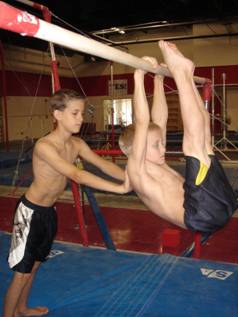
Do not push the shoulders too far forward when working on the single bar
If training without a partner, in order to get the maximum benefits from these movements, you will need to monitor yourself assiduously to make sure that you are maintaining correct form.
The ProgressionHere is my progression for developing hanging leg lifts. Simply begin the progression at the point best suited for your present strength. Train the static holds until you can comfortably hold the Ls and Vs for at least 10 seconds.
For developing a high degree of relative strength, I have found that one set is all that is required with the dynamic movements. Perform one set of three reps with a tempo of 3 seconds lift, 1 second pause and 3 seconds lower (313).
No speed counting please.
A traditional training schedule of Monday, Wednesday and Friday will work well, but my preferred schedule, where I have seen the greatest results, is Monday, Tuesday, Thursday, and Friday. As I have mentioned previously in other articles, this schedule of maximum work combined with substantial rest seems to be the most beneficial for my athletes.
1)
Hanging Tuck L - From a hang, tuck your legs and attempt to pull them up to horizontal. Keep the head neutral and the elbows locked. If you are unable to reach horizontal, simply lift as high as you are able. Hold for time.
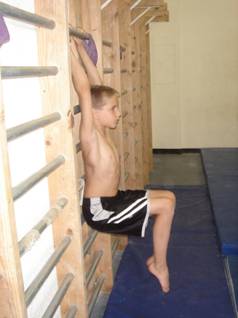
Note that the feet are under the knees rather than tucked to the glutes2)
Hanging Straight Leg L - Same as above, however the legs are now straight. Done perfectly, the elbows should be locked and there should be no leaning back during the lift or hold.
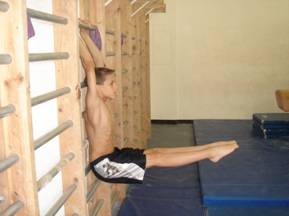
Focusing on keeping both the shoulders and hips on the bars will help to maintain a flat back; an essential element of a correct L.3)
Hanging V - From a hang, tuck your legs to your chest and then extend them up overhead to the bar. Do not hook your feet on the top of the bar for assistance in the position. Do not bend your elbows. Hold for time.
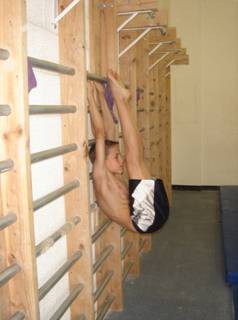
This is a perfect example of a static hanging VAt first, it may be necessary to perform this exercise with bent knees, bent elbows and closed shoulders. In fact you may find that initially your current levels of strength and flexibility will not allow you to come even remotely close to a hanging V. Simply over time continue attempting to straighten the knees/elbows and to open the shoulders until you are able to achieve the correct position.
With regards to the shoulder position, their being in a "closed" or "open" position refers to the angle between the upper arms and the torso. The axis of the angle would be the armpits. A smaller angle would be referred to as closed. A completely closed shoulder angle would be with the arms next to the sides. A larger angle would be referred to as open. A completely open shoulder angle would be with the arms extended up over the head.
During a leg lift it is only possibly to keep the shoulders completely open if the feet stop a little in front of the bar. In order to bring the feet to the bar, it will be necessary to allow the shoulder angle to close somewhat. However strive to keep the closure to the minimum required to complete the movement.
4)
Leg Lift to L - From a hang, with straight legs pull up as close to a horizontal L as you can. Lower and repeat. Remember to maintain the proper tempo during the movement. Do not rest at the bottom in between reps; there is a great difference between one rep done three times and one set of three reps.
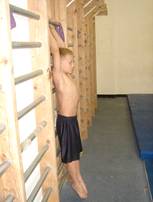
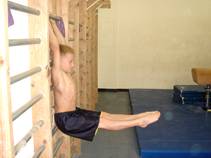
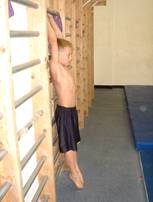
Keeping the knees locked will greatly increase the active flexibility component of this exercise.5)
Hanging V lower to L & Return to V - From a hanging V, lower as close as you can to the L and then pull back up to the V.
At first, you may only be capable of a very small range of motion. That's fine. The key here is patience, consistency and persistence. Progress is not made in giant leaps, but rather in very small, almost immeasurable improvements. I tend to think of each day of training as a page in a novel. Taken individually, each page is so thin as to be almost not worth considering. Yet if one page were added to the total over the course of a year, in the end we would have a substantial novel of 365 pages. In my opinion, it is the same with physical preparation. In fact I have used this exact method to develop all of my champions both in terms of physical preparation and technical refinement.
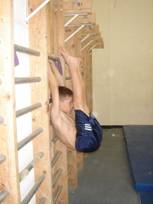
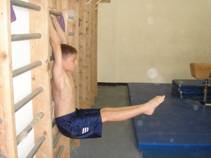
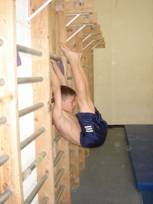
Combine this exercise with the Leg Lift to L to develop both sides of the hanging leg lift6)
Full Hanging Leg Lift - From a hang, pull the toes up to the bar. With this particular variation it is fine to allow the feet to go above the bar. Just strive to keep your feet as low as you are able. Also be careful to ensure that the elbows and knees remain straight.
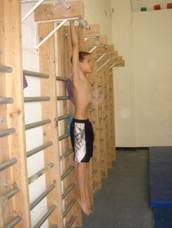
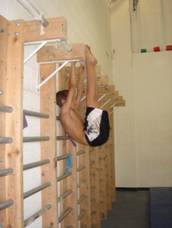
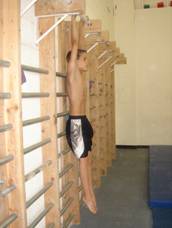
Depending on the exercise taller athletes may need to use the upper rail when working on the stall bars.7)
Full Hanging Leg Lift with Toes Below the Bar - From a hang, In this variation, the feet are below the bar at the top of the leg lift. Lifting the feet to a position under the bar, forces you to keep the shoulder angle open during the pull, which minimizes the amount of assistance the lats can provide and magnifies the amount of work done by the abs.
Begin with striving to get under the bar with the feet flexed and gradually progress to completing this exercise with toes pointed yet feet still below the bar at the top.
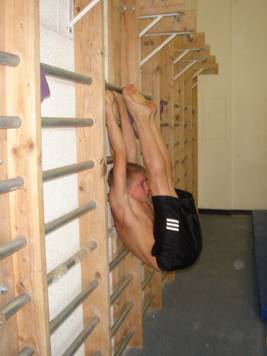
Notice the shoulder angle and the extremely straight knees necessary to maximize this movement as both a conditioning and an active flexibility exercise.8)
Weighted Leg Lifts - Finally we arrive at the weighted leg lift. All the regular guidelines for a correct leg lift continue to apply; now simply hang weight on the ankles to increase the intensity of the movement. With the movement now being done under load, the temptation will be especially great to bend the knees ? avoid this as it will severely undercut your progress.
Another common mistake here is to attempt to swing the weight up rather than lifting it under control. On some conditioning elements momentum is an essential component; weighted leg lifts however are not one of them. Be meticulous in maintaining the correct tempo.
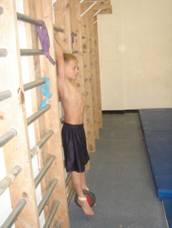

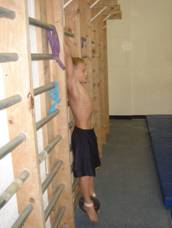
This athlete is using a little less than 10 lbs at a bodyweight of 65 lbs. Remember also that this is at a tempo of 313.The straps that we use to hang the weights on are sections of nylon strapping (available at Home Depot or Lowe's for about $.12 a foot) sewn into circles of 22"-25" circumference with a 1" overlap on each end. Keeping tension on the nylon strap by pulling the ankles slightly apart will help to prevent the weights from sliding around during the leg lifts.

The nylon strapping my athletes use for a variety of exercisesThe sky is the limit here, however do not plan on being able to pull enormous amounts of weight in this movement; the leverage is simply too disadvantaged. The most weight I have seen used is 15lbs. for reps. Generally my top athletes add anywhere from 10-15lbs on the ankles for this movement; which works out to an incredible 15% to 20% of their bodyweight.
The reason that most people fail to make progress on weighted leg lifts is simply that they try to use conventional plates during their training. For example, let's say that you are using the smallest conventional weight plate available; a 1.25 lb plate. You build up to three repetitions with a 313 tempo. Your training is going well and it is time to progress to the next level and you add another 1.25 lb plate. You are now attempting to train with 2.5 lbs of extra resistance - an increase of 100%. It doesn't require a great deal of imagination to see that in only a very short time, gains in this movement will quickly grind to a halt as the jumps in added resistance are simply too great for such a leverage disadvantaged movement.
On the other hand, fractional plates will allow training to progress in increments of .25lb guaranteeing continued long term gains.

Fractional PlatesExcept for occasional forays to break up the monotony of training and some specialized equipment exercises, I do not train my athletes with high repetitions during physical preparation. I am far more interested in the generation of athletic power than I am in the development of endurance. The stronger and more powerful an athlete is, the higher the degree of athleticism they will be capable of exhibiting. To that end, I find that weighted leg lifts are the far more beneficial choice for future athletic excellence then endless high rep sets of the weightless variety.
 Christopher Sommer is the Men's Head Coach At the Dessert Devil Gymnastics National Team Training Center in Mesa, Arizona and has the one of the premiere men's gymnastics programs in the United States. He can be reached at OlympicBodies@aol.com or visit his website at OlympicBodies.com.
Christopher Sommer is the Men's Head Coach At the Dessert Devil Gymnastics National Team Training Center in Mesa, Arizona and has the one of the premiere men's gymnastics programs in the United States. He can be reached at OlympicBodies@aol.com or visit his website at OlympicBodies.com.
Since his last article came out in October 2004, Coach Sommer has been unbelievably busy. Among other things, he has: 1) put another athlete on the Men's Jr. National Team 2) this athlete also earned a silver medal at the 2005 Junior National Championships and in the process became the youngest medalist in USA Gymnastics history 3) had the opportunity to train some Navy SEALS, Air Force Para Rescue, undercover DEA, Hostage Rescue and FBI among others. 5) been spending a large portion each morning working on his three books. 6) putting the finishing touches to his Power Levers before bringing them to market. 7) begun the filming for his first DVD 8) completed another undefeated competitive season. 9) and occasionally even gets to spend time with his wife and children.
Back